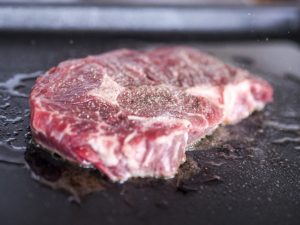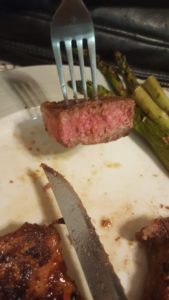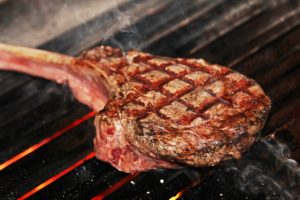
Once or twice a week I like to cook up a nice juicy steak, as I believe in consumption of animal-based products. My favorite is a ribeye due to its fat content. I always look for good marbling and a good layer of fat on the outside, and a ribeye fits the bill. As for how to cook a ribeye, it’s pretty simple.

In fact, for best results I find less is more. You don’t need a lot of this and that and the other.
What is ribeye?
The ribeye is a cut of meat that comes from the rib section of the cow, spanning from ribs six through twelve. In the United States, a ribeye with the rib bone still in place is a “bone-in ribeye.” In Australia, a bone-in ribeye is known simply as a ribeye, while a bone-out ribeye is known as a “Scotch fillet.”
It’s a relatively fatty cut of meat due to its location on the upper ribcage, an area that gets relatively little movement.
Choose your cut of meat
Pick out the best you can afford, but preferably grass-fed.
I always say to get the best you can afford, simply because it’s still more nutritional than 99% of items you find in a supermarket. A less-than-prime piece of beef is better for you than Hamburger Helper. Just look at the ingredients on the box.
Look for something with good marbling, anywhere from 10-16 ounces per person. For my cut of steak, I always go for as close to 16 ounces (a full pound) as possible but will settle for 13 or 14 ounces. I’m a pretty big guy, so I need a solid steak.
Bone-in or bone-out? That’s up to you. There are benefits to both. That said, I think some of the best and most tender meat comes from the area immediately connected to the bone, which can sometimes get cut off. You’ll get a better deal per pound on bone-in, but remember, you’re paying for the bone which you obviously won’t eat.
Prep
If I get a steak at the store that I’m going to cook within a few hours, I don’t put it in the refrigerator. I leave it exposed to room temperature in the package.
The first thing I do when removing the steak from the package is to put it on the plate. I then salt the steak liberally with some pink Himalayan salt. Kosher salt works well too. You want a solid layer where you can actually see the salt on top.
The reason for salting is three-fold:
- Salt helps to bring out the flavor
- The salt will help tenderize the meat
- Juice retention–the key to a good end result
Always salt the steak on a plate. The steak will release some blood, and you’ll want something that can contain that blood without making a mess.
Once salted, let the steak sit at room temperature. Shoot for 30 minutes minimum per half an inch of thickness, up to 45 minutes.
At the end of your salting time, rinse both sides of the steak under cool water. Practically all of the salt will be gone from the exterior of the steak by this time as it will have penetrated the interior of the meat. Pat both sides dry with a paper towel and place on a separate, dry plate. This will leave the moisture on the inside of the steak where you really want it.

Once dried, add a fairly liberal coating of grated black pepper and a slight coating of pink Himalayan or Kosher salt to both sides. You’ll want a second go with the salt to complement the outside of the steak.
Cooking time
Put a frying pan on medium-high heat, let it warm up for 5-10 minutes. Don’t place your steak on a cold frying pan.
At the end of your 5-10 minutes place the steak on your hot frying pan, cover the pan, and let it cook for three minutes. You can put butter on the frying pan or steak first if you want, but I don’t find it necessary. To me, butter really doesn’t enhance the flavor and the steak’s own fat will provide enough moisture in the pan. I’ve used olive oil before too, but I didn’t care for the flavor combination.

Flip over for three more minutes, put the cover back on. This gets you a good medium-rare steak. Add another minute on each side for medium.

When you’re done, let it sit for 1-2 minutes for the temperature to hold before cutting into it and eating. The steak will cook slightly after taking it off the heat
Is it the right amount of time?
If you’re in doubt about how much time you’ll need to get the steak to your desired redness, err on the side of too short a time. You can always throw the steak back on the pan and give it a little more time, but once it’s overcooked, there’s no un-ringing that bell. Keep the frying pan heated until you get it to absolutely the right redness, then turn it off.
What frying pan should you use?
I’m not dogmatic when it comes to frying pans. Use what you can afford or what you already have. If possible, look into a cast-iron skillet that’s not rusty, even if you have to find it at a thrift store.

Many insist on cast-iron skillets. They’re great, but they’re not the most low-maintenance items you can get. You have to clean them a certain way.
Ceramic frying pans are also becoming increasingly popular.
If you want grill marks, the griddle pan is a terrific option. Grill the steak diagonally for 90 seconds, turn it 90 degrees, cook for 90 more seconds. Flip the steak and do the same thing on the other side.

Less is more
Remember–with a great steak, less is more. You don’t need garlic salts, and lemon pepper, and this salt, and that salt, and all the other things. Over-spicing isn’t necessary. Salt, pepper, optional butter. That’s it. No need to go overboard.
Taste the meat, not the spices. Eat up.
This post may contain affiliate links. See Animalbasedlife.com’s Affiliates Disclosure here.
Did you try this recipe and like it? Do you have your own pointers? Feel free to leave a comment in the box below.

Leave a Reply